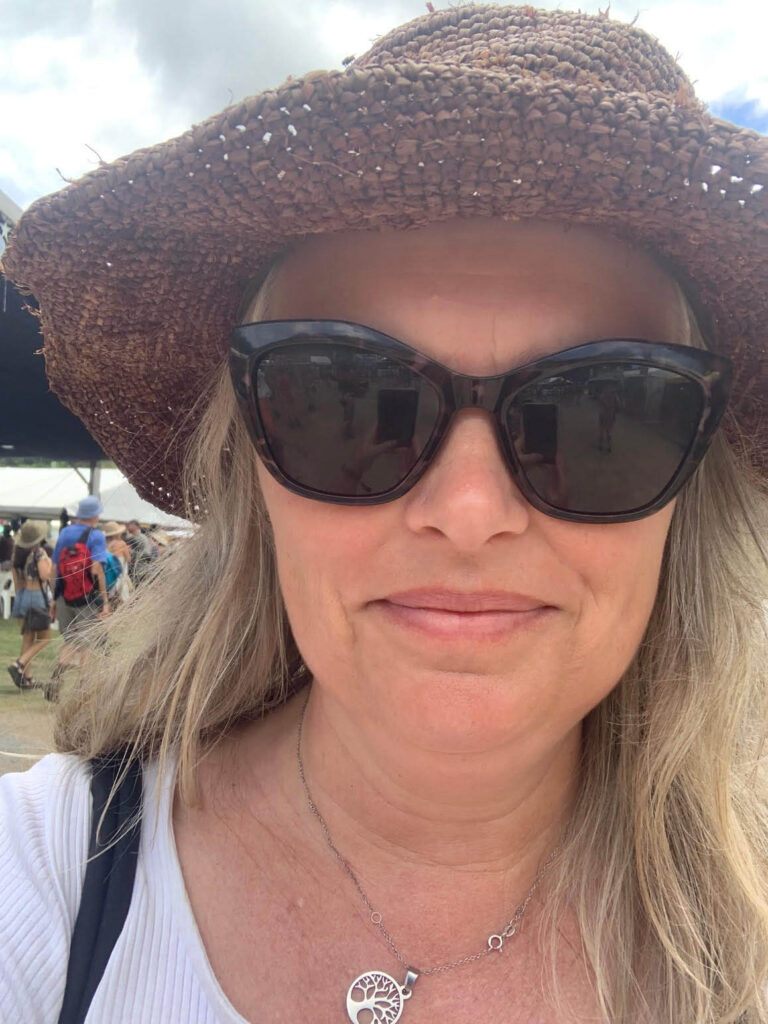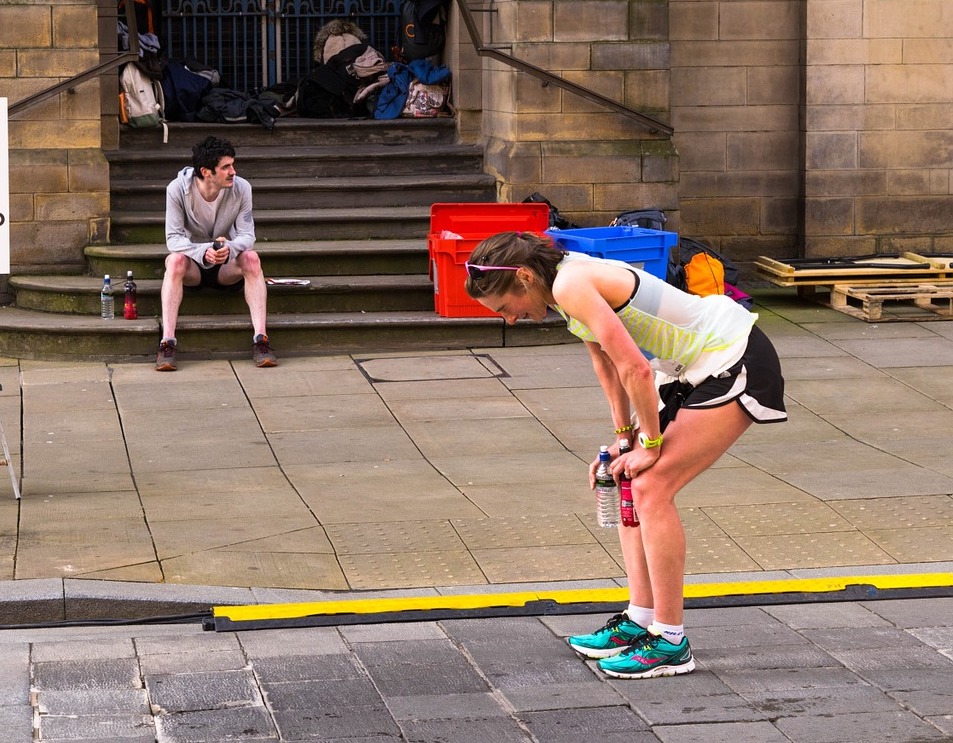Last year I drove all the way up to Woodford Queensland to volunteer in the homeopathy tent at the festival. It was fantastic! But… half-way there, I had to stop for a bush-wee as I got a little caught short (‘scuse my directness, life’s too short to pussyfoot around for these things these days). That wasn’t a problem in itself. The problem I had was that back in the days when I did that kind of thing more often (ahem), I could crouch down and then get back up again no problem. This time, I got stuck. My legs were so weak, I couldn’t push myself back up to standing and I had to kind of collapse onto my butt first in a very unbecoming sprawl into the roadside weeds. I also struggled to put my tent up, because my arms were limp, wet noodles. I wish they were also skinny like noodles, but I noticed I’d been growing fedoobedas, or to be more technical, tuck shop arms – you know, those flappy bits that replace your triceps when the dreaded menopause wreaks its slow-motion destruction over the years.
Not only that, when I look back, I realise there was this sub-conscious part of me that lived in increasing fear of being injured, which made me tiptoe even more around doing physical stuff. What if I hurt my knee or ankle and couldn’t walk? That’s my worst nightmare, especially being a single mum. What if my shoulder started playing up? Or what if I subluxated a rib and ended up in agony? This fear was actually holding me back from engaging in more vigorous weight-bearing activities. Instead of avoiding them for fear of injury, I should have been throwing myself into them. Being stuck in a squat, and then needing to ask for help putting my tent up were seminal moments in making me face the fact that I needed to face my fears before they became reality.
When I got back from Queensland, I started struggling with opening jars, ripping the plastic off the stoopid meat packaging they use now at supermarkets (never struggled with the old ones), and carrying in the shopping. I was also noticing an increasing difficulty regulating my blood sugar, which was really annoying as I’ve been doing everything right. I’ve been eating a really sensible, healthy (boring) diet with loads of protein and fibre. I’ve been avoiding grains which are a disaster for me. I’ve been walking the dog every morning and doing other stuff here and there like 5Rhythms dance and swimming and all kinds of other bits and pieces. I felt like an old woman, and being only fifty-one at the time, I wanted to make sure that the next half of my life would be of the same good health as what came before.
You may have seen it bandied around here and there on social media. Big, buffed men talking muscle mass and metabolism. You might be thinking, what’s that got to do with me? Well, the answer is, no matter what age or gender, a lot! However, muscle mass plays an especially important role as we age and is one of the most key predictors of longevity in older adults. Not only that, more recently it has been found that we women start to lose muscle mass in our late thirties to early forties. It’s called sarcopaenia, and has one of the most fundamental impacts on whether we age well or badly. Men go through something similar, although for women the declining hormones are more pronounced and that causes a steeper decline over a shorter period than for men.
New research coming out is finding that even if we have a little bit more wobbly stuff covering our bodies than we’d really like, the most important of all (when it comes to metabolic health) is about the strength and mass of the muscle underneath.
You might be familiar with the body mass index measurement, or BMI for short. For a long time, this measurement was seen as the pinnacle of standards. This is very unfortunate as it has skewed the parameters of what is normal for many years, to many people’s detriment. It does not take into account the difference between muscle mass and body fat.
In fact, the BMI originated in post war England from a life insurance company who made racist parameters of what the ideal body weight and measurements should be. Furthermore, it does not take into account ethnic variation and favours the traditional European body type.
An alternative to this flawed method of measurement is the waist to height ratio, which is still not completely ideal as it doesn’t take individual circumstances into account, but it is more effective and relevant than the BMI.
So, why is muscle mass so important?
Here’s the lowdown, and more info to come for those wanting to get their teeth stuck in a little more.
- Greater metabolic health = less chance of metabolic syndrome and type 2 diabetes
- Better cardiovascular health
- Slowing the degenerative ageing process
- Coping better with the everyday physical challenges of life such as opening jars, carrying shopping and better mobility
- Joint health improvements, less aches and pains and stiffness, reducing risk of injury
- Improving energy levels
- Bone density improvements
- Better mental health and quality of life
- Better body tone and looking fabulous as it leads to fat burning
Metabolic health
As mentioned above, muscle mass is one of the most important dictators of metabolic health. This means that, even if your diet is perfect, if your muscles have gone to limp noodle status because of a lack of regular strength training, your blood glucose control is likely to go out the window. Why is this so important? Think about insulin, the hormone responsible for packaging up glucose and pushing it into your cells for much needed fuel. There are many insulin receptors in our muscles, and we need to be able to work those muscles in order to “wake up” the insulin receptors and make them take in glucose, one of the fuels our muscles like to use.
When our muscle mass is at limp noodle status, it causes a decline in insulin sensitivity. Basically, this means that the insulin has to work much harder, and we need far more of it in order for it to do its job. The higher our insulin levels, the more the insulin bombards the receptors, and the less sensitive those insulin receptors become. Not to mention the poor pancreas which starts to get fatigued by pumping out all that insulin. Unfortunately, it doesn’t stop there. Having high insulin causes all kinds of other issues such as increased fat production, increased risk of high blood pressure and a whole bunch of other issues.
Not only that, dysregulated blood glucose levels can also mess with our reproductive hormones, especially females. This is something to think about when looking at weight gain and all the other not-so-nice symptoms during menopause. It is also commonly known that chronically high blood glucose (and therefore insulin) levels are associated with chronic inflammation which is a major source of tissue degeneration and ageing.
Cardiovascular health
One of the most important predictors of cardiovascular health is blood glucose control. If we are able to control our blood glucose and not send insulin levels up too high, we have greater chance of heart and blood vessel health. Recent studies on muscle mass found that even if people are obese, if they have a large amount of muscle mass, they are less likely to suffer from cardiovascular disease than those who are obese and have lower muscle mass. Of course, those who had less fat levels in their body and increased muscle mass were the ones least likely to suffer from cardiovascular issues. In fact, one such study suggested that increased muscle mass led up to 80% reduction in cardiovascular disease risk. Again, this comes back to metabolic health, much of which is dictated by insulin sensitivity.
Inflammaging
Inflammaging is the new, trendy buzzword going around social media at the moment and while I’m not really into trends, this one has really got my attention. The reason why? It’s inflammation that causes ageing. And one of the most important causes of inflammation is metabolic disease, which can also be defined as the inability to regulate our blood glucose levels. It’s way more complex than this, and gut health plays a massive role in this. We could be eating a ketogenic diet, exercising in all the right ways and doing everything we think we need to in order to stay healthy. But if we are eating foods that cause inflammation at the gut level, this can bring on inflammation and also cause us to have compromised insulin sensitivity. We need to pay attention to any messages our body is giving us that may tell us those foods are causing us inflammation at the gut level. Clues may include bloating, cramping, diarrhoea, constipation, fluid retention, weight gain, brain fog and body aches/stiffness. These issues can also flag other more chronic diseases so if you are suffering from any of these, make sure you seek professional help.
Joint health, bone density and energy levels
When we do regular strength and flexibilty training, the muscles are being worked as they should and this keeps the joint capsules moving and clearing out toxins, leading to better joint lubrication and a reduction in inflammatory substances sitting around in the joint. It’s the same story with our muscles. Lactic acid and other substances can sit around and build up in unexercised joints and muscles, leading to aches, pains and stiffness. Not only that, if those muscles and joints are regularly doing what they’re supposed to be doing, the muscles and tendons/ligaments will be stronger and more resistant to injury. It’s weak, inflexible joints and muscles that are more easily injured, and the less muscle mass we have, the more we creep around in fear of being incapacitated by an injury.
It is also now common knowledge that regular weight bearing exercise is essential for maintaining our bone density through our peri/menopausal years and beyond by retaining mineral levels and stimulating the cells responsible for producing bone tissue. Remember, if we don’t use it we lose it.
That brings us to energy levels. Our muscles are rich in mitochondria which are the energy powerhouses of our cells. If we engage in sensible exercise habits not only do we increase muscle and bone mass, we also increase the amount of mitochondria in those muscles, and that means more energy to get through our day. We are also improving our glucose metabolism which then improves our energy levels as our cells and tissues are actually getting the fuel they need to make the energy.
Mental health
One other thing about exercise is that it can help us clear cortisol and other stress hormone levels. Remember, if we are stressed, our body prepares us to run or fight and this means that blood glucose is increased, and our bodies are expecting some vigorous movement. What we usually do instead is to sit there fuming for hours on end, stewing in our stress-juices until our bodies ache and we struggle to sleep. Regular strength and flexibility training can help us clear these stress hormones and calm our nervous systems too. Our bodies are actually designed to need physical exercise to calm down, otherwise we hold onto those stresses way longer than we need to.
And we look way more fabulous
Of course, looks aren’t the be-all-and-end-all of life but it sure helps the confidence to shrink those fedoobedas and saddle bags and meno-tummy-pooch down to mere shadows of their former selves.
Protein and other vital things to consider if you want to build muscle mass
 Muscles are made out of protein. If we don’t get enough protein in our diets, we can’t make muscles even if we exercise as we should. Protein is needed more than ever around menopausal age, and it is recommended that we eat around one gram of protein for every kilo of body weight. So for an average menopausal woman, we need 60-80g of protein in our diet every single day. We also need to make sure we have good strong stomach acid to ensure we are able to digest all that protein. And then we need to add in good quality fats in order to ensure all those biochemical processes are working to full capacity, not to mention the quality slow-burn carbs, micronutrients and phytochemicals in our veggies to influence anti-inflammatory pathways and other beneficial biochemical processes.
Muscles are made out of protein. If we don’t get enough protein in our diets, we can’t make muscles even if we exercise as we should. Protein is needed more than ever around menopausal age, and it is recommended that we eat around one gram of protein for every kilo of body weight. So for an average menopausal woman, we need 60-80g of protein in our diet every single day. We also need to make sure we have good strong stomach acid to ensure we are able to digest all that protein. And then we need to add in good quality fats in order to ensure all those biochemical processes are working to full capacity, not to mention the quality slow-burn carbs, micronutrients and phytochemicals in our veggies to influence anti-inflammatory pathways and other beneficial biochemical processes.
How often and what can we do?
There are a lot of different perspectives on this. We menopausal women are very stress sensitive, which means we need to make our exercise sessions count and ensure we also allow for our nervous systems to have the rest they need in order to effectively switch off. There are many different suggested activities but from what I noticed when I took a brief foray down the rabbit hole of the best exercises to do regularly during menopause. Many sites will say that jogging and cardio are great, but I know from hearing from many of my menopausal clients that it can raise cortisol too much and actually cause weight gain and exhaustion.
So maybe just take those sites that push butt-loads of cardio with a grain of salt, because from what I’ve read, the most important thing is to get short, high-intensity bursts which don’t smash the adrenal glands too much like a long jog might.
What I found was that when I first started on my little sessions in front of a movie or series on the telly (that’s what works for me), I started very over-enthusiastically on four to five afternoons/evenings a week. I’ve done a lot of yoga and pilates over the years and decided that for me, I’m suddenly either in the mood or I’m not, so I have to grab my yoga mat and weights and just do it then and there in my loungeroom. Otherwise trying to fit into classes at the gym is just too difficult around all my work and family commitments. Doing this so often got me really good and fast results, but I couldn’t keep it up with the busyness of my life, and my adrenals really started to suffer, leading to insomnia and feeling wired. I’ve settled on two to three sessions per week, which isn’t quite as awesome for my tummy-and-arm-wobblies as four or five sessions, but my nervous system is thanking me and it’s a nicer balance all round. And now, I’m feeling strong! Maybe I’m not quite ready to take on my teenage boys in arm wrestling, but I celebrate lifting bags of shopping, and love to flex my muscles along with my boys at the dinner table.
Whatever you choose to do, just make sure that you get the balance right for you between challenging yourself in a healthy way within your limitations, rather than pushing yourself too far beyond them. Also, make sure you find some time to rest and recover. After all, we are way more sensitive at this time in our lives, and it’s high time that we claim some quality us-time.
- The importance of Muscle Mass in menopause - 12/03/2025
- Penny’s gluten free bread recipe - 14/10/2024
- Children and bedwetting: What can parents do to help? - 01/10/2024




